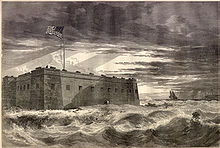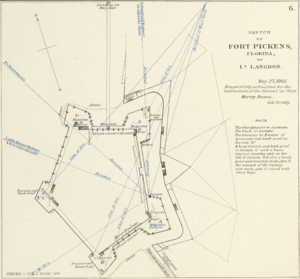
Fort Pickens
Encyclopedia

United States
The United States of America is a federal constitutional republic comprising fifty states and a federal district...
military fort on Santa Rosa Island
Santa Rosa Island, Florida
Santa Rosa Island[p] is a 40-mile barrier island located in the U.S. state of Florida, thirty miles east of the Alabama state border...
in the Pensacola, Florida
Pensacola, Florida
Pensacola is the westernmost city in the Florida Panhandle and the county seat of Escambia County, Florida, United States of America. As of the 2000 census, the city had a total population of 56,255 and as of 2009, the estimated population was 53,752...
, area. It is named after American Revolutionary War
American Revolutionary War
The American Revolutionary War , the American War of Independence, or simply the Revolutionary War, began as a war between the Kingdom of Great Britain and thirteen British colonies in North America, and ended in a global war between several European great powers.The war was the result of the...
hero Andrew Pickens
Andrew Pickens (congressman)
Andrew Pickens was a militia leader in the American Revolution and a member of the United States House of Representatives from South Carolina.-Early life:...
. The fort was completed in 1834 and remained in use until 1947. Fort Pickens is currently part of the Gulf Islands National Seashore
Gulf Islands National Seashore
Gulf Islands National Seashore offers recreation opportunities and preserves natural and historic resources along the Gulf of Mexico barrier islands of Florida and Mississippi. The protected regions include mainland areas and parts of 7 islands...
, and as such, is administered by the National Park Service
National Park Service
The National Park Service is the U.S. federal agency that manages all national parks, many national monuments, and other conservation and historical properties with various title designations...
.
History
After the War of 1812War of 1812
The War of 1812 was a military conflict fought between the forces of the United States of America and those of the British Empire. The Americans declared war in 1812 for several reasons, including trade restrictions because of Britain's ongoing war with France, impressment of American merchant...
, the United States decided to fortify all of its major ports, and as a result, French engineer Simon Bernard
Simon Bernard
Baron Simon Bernard was a French general of engineers. Born in Dole, Simon Bernard was educated at the École polytechnique, graduating as second in the promotion of 1799 and entered the army in the corps of engineers....
was appointed to design Fort Pickens. Construction on Fort Pickens lasted from 1829 to 1834, with 21.5 million bricks being used to build the fort. Much of the construction was done by slave labor.

Fort Barrancas
Fort Barrancas or Fort San Carlos de Barrancas is a historic United States military fort in the Warrington area of Pensacola, Florida, located physically on Naval Air Station Pensacola....
, Fort McRee
Fort McRee
Fort McRee, was a historic military fort constructed by the United States, on the eastern tip of Perdido Key, to defend Pensacola and its important natural harbor...
, and the Navy Yard. Located at the western tip of Santa Rosa Island, just offshore from the mainland, Pickens guarded the island and the entrance to the harbor. Its construction was supervised by Colonel William H. Chase of the U.S. Army Corps of Engineers. Ironically, Chase was later appointed by the State of Florida to command its troops and seize for the South the very fort he had built.
By the time of the American Civil War
American Civil War
The American Civil War was a civil war fought in the United States of America. In response to the election of Abraham Lincoln as President of the United States, 11 southern slave states declared their secession from the United States and formed the Confederate States of America ; the other 25...
, Fort Pickens had not been occupied since the Mexican-American War. Despite its dilapidated condition, Lieutenant Adam J. Slemmer
Adam J. Slemmer
Adam Jacoby Slemmer was an officer in the United States Army during the Seminole Wars and the American Civil War, as well as in the Old West.-Early years:...
, in charge of United States forces at Fort Barrancas, determined that Pickens was more defensible than any of the other posts in the area. His decision to abandon Barrancas was hastened when, around midnight of January 8, 1861, his guards repelled a group of local men intending to take the fort. The fort was also reinforced by troops and material that were brought by Gen Meigs, who had been sent by Lincoln and Sec Seward. Meigs was also the engineer who was responsible for building the Washington aqueduct and getting the dome on the US Capital. Some historians suggest that these were the first shots fired by United States forces in the Civil War. Shortly after this incident, Slemmer destroyed over 20,000 pounds of gunpowder
Gunpowder
Gunpowder, also known since in the late 19th century as black powder, was the first chemical explosive and the only one known until the mid 1800s. It is a mixture of sulfur, charcoal, and potassium nitrate - with the sulfur and charcoal acting as fuels, while the saltpeter works as an oxidizer...
at Fort McRee, spiked the guns at Barrancas, and evacuated about eighty troops to Fort Pickens. Despite repeated Confederate military threats to it, Fort Pickens was one of the few Southern forts to remain in Union hands throughout the Civil War.
From 1886 to May 1887, the famous Apache Indian Geronimo
Geronimo
Geronimo was a prominent Native American leader of the Chiricahua Apache who fought against Mexico and the United States for their expansion into Apache tribal lands for several decades during the Apache Wars. Allegedly, "Geronimo" was the name given to him during a Mexican incident...
was imprisoned in Fort Pickens, along with several of his warriors. Their families were held at Fort Marion.
During the late 1890s and early 20th century, new gun batteries were constructed at Fort Pickens. These batteries were part of a program initiated by the Endicott Board, a group headed by a mid-1880s Secretary of War, William Endicott. Instead of many guns located in a small area, the image most people have of a fort, the Endicott batteries are spread out over a wide area. This system used dispersement and concealment for protection from naval gunfire, which was more accurate and powerful than in the past. The use of the modern, powerful weapons eliminated the need for the concentration of guns that was common in the Third System fortifications. One such battery, called Battery Pensacola, was constructed physically within the walls of Fort Pickens, while other similar concrete batteries were constructed to the east and west as separate facilities. The ruins of these later facilities are also included in the Gulf Islands National Seashore
Gulf Islands National Seashore
Gulf Islands National Seashore offers recreation opportunities and preserves natural and historic resources along the Gulf of Mexico barrier islands of Florida and Mississippi. The protected regions include mainland areas and parts of 7 islands...
complex.
On June 20, 1899, a fire in Fort Pickens' Bastion D reached the bastion's magazine, which contained 8000 pounds (3,628.7 kg) of powder. The resulting explosion killed one soldier and obliterated Bastion D. The force of the explosion was so great that bricks from Bastion D's walls landed across the bay at Fort Barrancas, more than 1.5 miles away (2.4 km).
Nearby Fortifications
A companion fortification, Fort McReeFort McRee
Fort McRee, was a historic military fort constructed by the United States, on the eastern tip of Perdido Key, to defend Pensacola and its important natural harbor...
, was located across Pensacola Pass
Pensacola Pass
Pensacola Pass, separating mainland Florida from Santa Rosa Island, is the mouth of Pensacola Bay.Pensacola Pass forms a water passage that connects Pensacola Bay with the Gulf of Mexico to the south, in the U.S. state of Florida, east of the Alabama/Florida state line. The surrounding area is...
from Fort Pickens on Perdido Key. Abandoned by Union forces and taken over by Florida and Alabama militia in January 1861, it was badly damaged by Union bombardment during the American Civil War later that year. Abandoned by Confederate forces, battered and burned is how Fort McRee remained for the next three decades. Although subjected to improvements in the late 19th century during the run-up to the Spanish American War, the fort was struck by a hurricane 26–27 September 1906 that destroyed most of the newer structures that had been erected since 1898. After the hurricane, only a minimal caretaker staff remained to ensure the security of the site and Fort McRee once again fell into disuse. Due to its location on a site accessible only by foot or boat, Fort McRee was left to the elements. Storms and erosion took their toll on the site and today, nothing more than a few scattered foundations remain.
Fort Barrancas
Fort Barrancas
Fort Barrancas or Fort San Carlos de Barrancas is a historic United States military fort in the Warrington area of Pensacola, Florida, located physically on Naval Air Station Pensacola....
, which was built around previously constructed 17th- and 18th-century Spanish forts, as well as Fort Barrancas' associated Advanced Redoubt approximately a mile (1.6 km) to the northwest of Fort Barrancas, are located across Pensacola Bay from Fort Pickens on the grounds of what is now Naval Air Station Pensacola
Naval Air Station Pensacola
Naval Air Station Pensacola or NAS Pensacola , "The Cradle of Naval Aviation", is a United States Navy base located next to Warrington, Florida, a community southwest of the Pensacola city limits...
. At the same time the Union forces abandoned Fort McRee in 1861, they also abandoned Fort Barrancas. This fort was also occupied by Florida and Alabama militia forces that were subsequently integrated into the Confederate forces. In May 1862, after hearing that the Union Army had taken New Orleans, Confederate troops abandoned Pensacola and Fort Barrancas and the fort reverted back to Union control.

